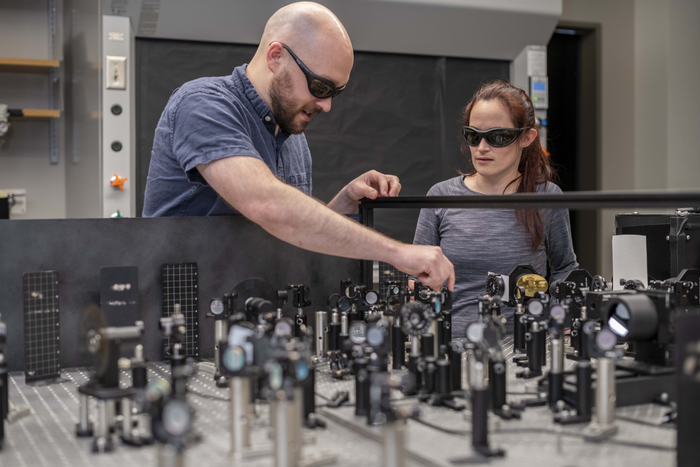KINGSTON, R.I. – Dec. 8, 2022 – Assuring that a growing global population has access to clean water will require new water treatment methods. One of these next-generation methods involves a form of iron called ferrate, which creates fewer toxic byproducts than chemicals like chlorine and is potentially cheaper and easier to deploy than complex ozone treatment systems.

Credit: URI Photo/Michael Salerno
KINGSTON, R.I. – Dec. 8, 2022 – Assuring that a growing global population has access to clean water will require new water treatment methods. One of these next-generation methods involves a form of iron called ferrate, which creates fewer toxic byproducts than chemicals like chlorine and is potentially cheaper and easier to deploy than complex ozone treatment systems.
For ferrate to work best, however, it needs to be combined with other compounds or excited by light energy. Now, using a technique involving ultra-fast laser and X-ray pulses, a team of University of Rhode Island researchers has revealed new details about the chemical reaction that occurs when ferrate is exposed to visible and ultraviolet light. The findings, published in the Journal of the American Chemical Society, could help researchers to optimize its use in water treatment applications.
“The light activation of ferrate has really never been investigated in detail,” said Dugan Hayes, an assistant professor of chemistry at URI and the study’s corresponding author. “In this study, we were able to reveal some of those photophysical properties for the first time.”
Ferrate is an oxidant, meaning it can break down contaminants by stealing their electrons. On its own, ferrate is a fairly strong oxidant. But when excited by light, it produces an even more powerful oxidant known as Fe(V) (or iron-5+). Before this new study, however, it wasn’t known just how much energy was required to produce Fe(V), and in what quantities it could be produced.
To find those things out, Cali Antolini, a Ph.D. student in Hayes’ lab, led experiments using transient absorption spectroscopy, a technique that investigates photochemical reactions using ultra-fast laser pulses. An initial pulse initiates a reaction, while subsequent pulses probe the reaction steps as they play out. The speed of the pulses—on the order of a few quadrillionths of a second—gives researchers a detailed record of even the shortest-lived reaction products.
Antolini carried out experiments using ultraviolet and visible light pulses using facilities at URI. She performed similar experiments using X-rays at Argonne National Laboratory’s Advanced Photon Source in Chicago, where Antolini works as part of a Department of Energy student research program.
The work showed that the conversion rate from ferrate to the highly reactive Fe(V) was about 15%. That’s roughly similar to the radical production of ozone purification systems. The research also produced surprising results related to the type of light needed to produce the more reactive iron species. The team found that a range of light wavelengths, stretching from ultraviolet spectra nearly into the visible, should be able to produce Fe(V). That’s an important finding for two reasons, the researchers say. Visible light takes less energy to produce that ultraviolet light, which could make ferrate excitation more energy efficient than had been previously assumed. Plus, visible light scatters less in cloudy water, meaning Fe(V) can be produced in a wide variety of water conditions.
The results are encouraging to Joseph Goodwill, an assistant professor of civil and environmental engineering at URI and a study coauthor. Part of his research program is finding ways to bridge the “clean water gap” between larger urban water treatment systems and small rural systems.
Ferrate-based purification systems are a promising option for smaller systems, where expensive and elaborate ozone systems aren’t practical, Goodwill says. Ferrate also has the potential to decrease reliance on harsh chemicals like chlorine, and may even eliminate stubborn contaminants that chlorine can’t remove. Those include per-/polyfluoroalkyl substances (PFAS), a class of chemicals increasingly found in wells and water systems across the U.S. But before ferrate systems can be widely deployed, scientists need a better understanding of ferrate chemistry.
“The formation of powerful oxidants from ferrate has been difficult to understand mechanistically, and this has blocked process optimization and full-scale implementation in water treatment applications,” Goodwill said. “The results presented in this paper improve our fundamental understanding of the ferrate system, which opens doors for applications.”
The researchers are hopeful that these new findings on how ferrate photochemistry works will help in expanding the use of iron-based water treatment.
The research was supported by the U.S. Department of Energy (DE-SC0019429 and DE-AC02-06CH11357) and the National Science Foundation (2046383).
Journal
Journal of the American Chemical Society
DOI
10.1021/jacs.2c08048
Method of Research
Experimental study
Subject of Research
Not applicable
Article Title
Photochemical and Photophysical Dynamics of the Aqueous Ferrate(VI) Ion
Article Publication Date
1-Dec-2022




